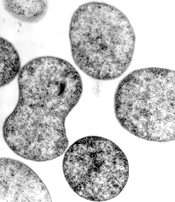
The Fierce and Fiery Microbe


|
NAME: Pyrococcus furiosus
IMAGE CREDITS: Henry Aldrich, haldrich@micro.ifas.ufl.edu
Click image to download large 640 x 480 JPEG image (approximate download times: 28.8 k = 40 sec; T1 = 11 sec.) |
How would you like to swim in boiling water? Although you and all plants and animals would quickly die in such hot water, the microbe Pyrococcus furiosus thrives in boiling water. This bacterium not only lives at hot temperatures, but it freezes to death at temperatures below 70 degrees Celsius. Microbes that thrive in boiling hot water are called "hyperthermophiles".
Not only do these exotic microbes live in boiling water, they do not breathe oxygen. In fact, oxygen kills them. Instead of oxygen, these fiery microbes breathe sulfur and exhale the stuff that gives rotten-eggs their smell: hydrogen sulfide.
Since these microbes like boiling hot water with no oxygen, they live in the hot water bubbling from undersea hot vents.
These bacteria are classified as members of the Archeae, one of two major groups of bacteria. Some scientists believe that the Archeae are the most direct descendants of the oldest life forms to inhabit Earth. Over 3 billion years ago, ancient Earth was probably steaming hot with little oxygen and plenty of sulfur, a comfy place for Pyrococcus to swim and enjoy life.

Glossary
bacterium - (plural = bacteria) - a simple, small microbe lacking a nucleus. Bacteria are also called prokaryotes or monerans. Most bacteria are unicellular, containing only a single cell. Sometimes bacteria appear multicellular, living together in groups of cells. Bacteria comprise two of the three domains of life, the Eubacteria and the Archaea.
© 1999 Comm Tech Lab, Michigan State University. This work was created with support from the National Science Foundation and the Center for Microbial Ecology at Michigan State University. Current maintenance is supported by the International Society for Microbial Ecology and the Comm Tech Lab.
![]()
